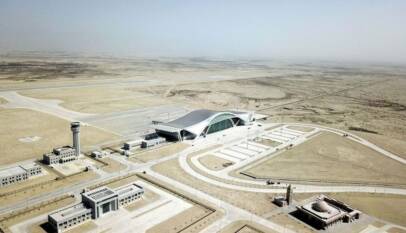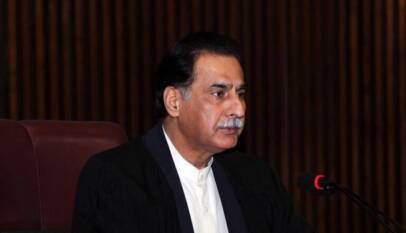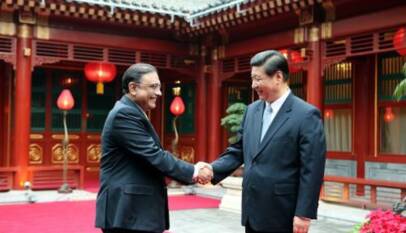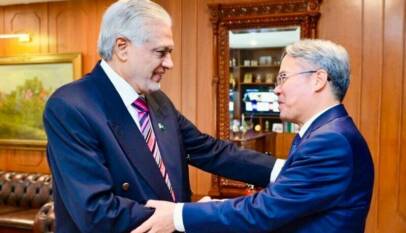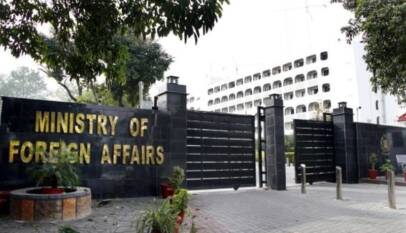Effects of CPEC will trickle down to Pakistan’s economy in 2020: Adviser Hafeez Shaikh
Prime Minister’s Adviser on Finance and Revenue, Dr Abdul Hafeez Shaikh said in an interview that in 2020 Pakistan will harvest the fruits of CPEC in its productive sectors of the economy, comprising industry and agriculture. The first phase of CPEC filled the infrastructure gaps through the early-harvest-projects of energy and transports and now in the second phase all resources would be utilized for the enhanced economic activities and job opportunities.
THE PTI government is expecting 2020 to be the year of economic recovery and job creation with the support of higher development spending, beginning of the second phase of the China-Pakistan Economic Corridor (CPEC) and revival of investor confidence.
In an interview with Dawn’s Business & Finance, Prime Minister’s Adviser on Finance and Revenue Dr Abdul Hafeez Shaikh said the government’s economic policies were already showing early signs of recovery and would be strengthened by supportive initiatives for key sectors like tourism, housing and private sector investment.
This would set the stage for not only job creation and reduce the cost of living but also create an environment that reflects Prime Minister Imran Khan’s vision of a welfare state.
The following are some key takeaways of the interview.
Investor confidence
Dr Shaikh hoped that 2020 will be the year where we see a revival of the export industry after a decade of stagnant exports. Since coming to power in August 2018, “our top priority has been to make local exports more competitive in the international market and boost foreign currency income”.
Towards this goal, the government has realigned the exchange rate to remove the anti-export bias and provided subsidy to the industry to make it more competitive in the international market.
This includes subsidy on gas (exporters are provided gas at 6.5 US cents compared to the average tariff of 9 cents) and power (7.5 cents versus the average tariff of 12 cents).
Similarly, the export industry has been provided subsidy on bank credit (lending at 5 per cent against the State Bank of Pakistan’s policy rate of 13.25pc).
On top of subsidies, the government is also working on enhancing market access for exports. The recently signed second Free Trade Agreement with China gives additional duty-free access to 313 product lines for local exporters.
These measures will help break the $26 billion barrier for exports in 2020. This will be a new record for Pakistan and will provide significant boost to the growth momentum for the economy.
Service exports are another area of focus for the government. A boost in tourism, including opening of the Kartarpur corridor, is expected to boost service exports to an all-time high of over $7bn in 2020.
Last year, the country saw record high remittances of $21.8bn as a result of greater confidence of overseas Pakistanis and incentives to banks to bring flows through banking channels. This was the first time that remittances crossed the $20bn barrier. The economic team is targeting remittances to continue to accelerate in 2020 to $22.8bn.
Foreign investment
The government’s economic tsar said that 2020 will also be the year where we see the return of foreign investment in Pakistan. After four years for net outflows, foreign portfolio investments into the local debt and equity markets have picked up sharply and the government is targeting inflows of $2.5bn in 2020. This is positive news for the capital market and will support higher foreign direct investment (FDI) inflows in 2020.
CPEC enters new phase
He said the second phase of CPEC will kick off during this year. “2020 will be year where the benefits of CPEC will start to trickle down through productive sectors of the economy, including industry and agriculture,” he said.
The first phase of CPEC (early-harvest projects) addressed key infrastructure gaps in the economy with focus on energy and transport bottlenecks. The second phase will build on the success of early-harvest projects and in 2020 resources will be focused towards generating greater economic activity and creating jobs.
CPEC’s second phase is focused on industrialisation, socio-economic development, agriculture modernisation and tourism promotion. Central to this phase is the development of three special economic zones (SEZs) on a priority basis, namely Rashakai (Nowshera), Allama Iqbal (Faisalabad) and Dhabeji (Thatta).
The SEZs will help attract large FDI into Pakistan and help to reverse the tide of de-industrialisation over the last 10 years. The government has announced incentives including tax holidays to attract Chinese business to make investments in Pakistan through joint ventures with local industry.
Dr Shaikh said the early signs of growth recovery and job creation were there on the horizon. “Greater investor confidence and pick up in exports and remittances will support recovery in growth in 2020”.
Macroeconomic stability has been achieved with the current account and fiscal deficits both showing significant improvements in the 2019-20 fiscal year, which led to international rating agency Moody’s upgrading Pakistan’s outlook to positive.
Growth recovery and job creation will be supported by higher government Public Sector Development Programme (PSDP) spending in 2020. The government has allocated Rs1.6 trillion in PSDP spending in 2020, an increase of 33pc from Rs1.2tr in the 2018-19 fiscal year.
Key investments in CPEC-related projects, including SEZs and infrastructure projects, are being fast-tracked. Similarly, 13 projects worth Rs287bn are being executed under the Prime Minister’s National Agriculture Emergency Programme.
Rules have been amended to expedite PSDP spending in 2020. Half of the approved funding will be undertaken in the first six months, leading to a significant pickup in economic activity.
On top of the budgeted PSDP spending, the government has finalised an ambitious three-year strategy around attracting higher private sector investments into infrastructure projects through public-private partnerships.
The development plan along with the PSDP aims to execute 53 mega projects with Rs5.2tr investment from the private sector to stimulate economic growth and create jobs for the youth.
Affordable housing
“Growth in 2020 will also be supported by a pickup in the construction sector,” he said. The government has approved an additional budgetary allocation of Rs30bn in the 2019-20 fiscal year for the low-cost housing sector.
This will cover the 10pc down payment by beneficiaries of affordable housing. The total impact of this stimulus to the economy would be equivalent to Rs300bn. On top of this, tax credits equal to 10pc of expenses related to these projects will be allowed to the developer for the first two years.
Inflation: the biggest challenge
Dr Shaikh promised a significant reduction in living costs during the year to 7pc. He conceded that inflation was the biggest challenge facing the economy in 2019. Average inflation measured through the Consumer Price Index (CPI) accelerated to 10.8pc during July-November 2019 compared to 6.1pc in the same period a year ago. The rise in inflation is a direct consequence of the economic challenges inherited by the PTI government, he said.
The biggest contributor to inflation has been the depreciation of the currency followed by adjustments in power and gas tariffs. When the PTI government took office, the current account deficit was at a record level of $20b, with dwindling foreign exchange reserves and large external debt payments looming ahead.
To avoid a default on debt obligations, the government had no option but to realign the exchange rate. Between August 2018 and December 2019, the rupee devalued by 25pc (from 124 to a US dollar to 154).
Similarly, the government inherited a power sector on the verge of a default. The sector’s circular debt was hovering near Rs1.2tr, whereas the circular debt in gas companies was Rs160bn by June 2018. This forced the government to adjust tariffs towards greater cost recovery, which added to inflationary pressures.
Ehsaas for the poor
Dr Shaikh said the year ahead would see a move towards making Pakistan a welfare state. In the 2019-20 budget, the government substantially increased pro-poor spending under the prime minister’s Ehsaas programme.
Budget allocation for the prime minister’s Ehsass program has doubled to Rs190bn in 2019-20, from Rs100bn a year ago. This includes an unconditional cash transfer program (BISP) of Rs5,500 per quarter to 5.1 million beneficiaries.
Under the Waseela-e-Taleem program, 3.2m children in 50 districts are receiving conditional cash transfer of Rs1,000 per quarter to reduce the dropout rate. The prime minister has recently launched the Ehsaas Undergraduate Scholarships Programme for 200,000 unprivileged children.
Similarly, the government has made a record allocation of Rs 152bn for merged districts of the erstwhile Federally Administered Tribal Areas for 10m of the most marginalised and vulnerable households.
Besides, health coverage under the Sehat Sahulat Program worth Rs720,000 per year per family has been extended to 42 districts, impacting 3.2m households.
More budgetary resources have also been allocated to shield the most vulnerable households from rising cost of living. A subsidy of Rs226.5bn has been allocated in the budget for customers who use fewer than 300 units of electricity in a month.
Similarly, a cross-subsidy is provided to the poorest households on gas tariffs. The GST rate on liquefied petroleum gas, used as cooking fuel by poor families, has been reduced to 10pc (from 17pc).
The year 2020 will see the government significantly scale up the prime minister’s Ehsaas programme and allocate a higher share of budgetary resources towards the poorest and most marginalised households across Pakistan. This will be a step towards realisation of our dream to make Pakistan a welfare state.
First Airbus lands at New Gwadar International Airport
ISLAMABAD, Jan. 30 (Xinhua) — The New Gwadar International Airport in Pakistan’…




